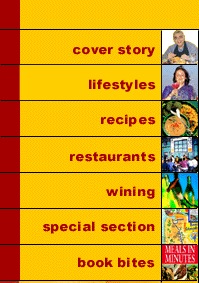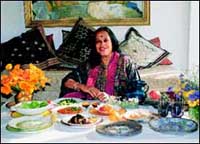



Masterpainter ANJOLIE ELA MENON invites JANNAT KHAN SHAW into her New Delhi kitchen-studio to partake of a masterpiece dinner of esoteric fusion cuisine. |
|
THERE are three things the celebrated painter Anjolie Ela Menon will religiously do every day at her Nizamuddin residence and studio in New Delhi. Paint. Play with her granddaughters. And cook. Paint, because she is one of India's great renaissance artists who spells magic and mystery with her subdued but brilliant canvases. Play with the grandchildren, because they are at that adorable age in toddlerhood and she is their doting grandmother. And cook, because if painting is in Anjolie's blood, then cooking is where her heart really is.
Unknown to most of the country's leading art connoisseurs, collectors and critics, Anjolie is one of New Delhi's big gourmets. She is a hands-on cook who has found her way about the kitchen by trial and invention and is now in the happy position to create at least 150 esoteric, unconventional recipes that could easily find their way into a Cordon Bleu cook book. Or, on the menu of an international restaurant specialising in fusion cooking.
Anjolie disagreed. "Cordon Bleu would be horrified by the way I take resourceful shortcuts in my cooking," she said looking shocked. "But still, I think it is important that I cook the way I do. I like to make my food memorable. I plan surprises. No chicken tandoori, mutter paneer and naan for me. I like to do the unpredictable. Like I do in my paintings, I add some small eccentric touch or detail that takes my food, or painting, away from the ordinary."
So, the Menon family is treated to some gourmet cooking out of Anjolie's kitchen on Sundays. "The food is South Indian and Bengali. Idli and aapam with chicken, mutton, prawns. Simple enough, but we really binge! Earlier, when I was younger, I was a more hearty eater. I relished all the baked and fried foods.
Now I eat less, and more carefully, because of my heart and pressure! More lean and basic foods. But occasionally I can be very brave! I can eat off the streets. I've been doing that in Delhi, Bombay, Bangkok, Hong Kong. Upset tummy and all! I'm wary about eating in five star restaurants that are full of hype and serve bad food. At home and outside, my accent is always on real food. I could eat in a dhaba rather than in a five star where they also sting you with taxes."
Anjolie is of the firm belief that while in a good painting, the contrast of colours is the basis of composition, in a gourmet meal, the contrasting colours and flavours should complement the food. "No two whites and two greens. Instead, I prefer to mix cultures and nationalities," she said, indicating that at home, the kitchen is her grand palette for cooking up colourful food.
"I come from a family of Bengali foodies. I've got gourmet genes. My grandmother, an American, was a great cook. I still refer to her Boston Cooking Schoolbook now and then. I have an aunt who is French, and she's equally amazing at nouvelle cuisine. My father, an army general, was a masterful chef. Occasionally, he cooked up a storm in the kitchen! My husband's family is Keralite, all good food lovers. My daughters-in-law are Punjabi, they are hearty eaters. And my sister has married and moved onto China. So... any wonder that I can cook some wonderfully imaginative meals!"
The afternoon I called upon her, Anjolie had turned out one of her special meals for UpperCrust. She read out the menu before producing the meal, like one of her masterpiece paintings, from the kitchen. Cold cucumber soup, an olive oil dip, doi machh, tomato tok, began bhaja... all done the Bengali way, except for the soup and dip.
"The soup I have invented," she admitted, "it has a masoor dal base, chicken stock, milk, raw cucumber and a little spinach for the colour. It is a blended soup, sauteed with onion, and it is served chilled in summer." The dip, she explained, was very popular with her friends. It had virgin olive oil, sundried tomatoes, coarse broken chillies and salt. "It is a variation of the Italian olive oil-chilli-salt. The sun-dried tomatoes give it the flavour."
The meal Anjolie served in a collection of fine translucent glass and porcelain plates that she had painted over with oils in bright, vivid colours and then had "fired" in a kiln at Baroda. She uses these as underplates, she said. Or, if you please, as miniature canvases for the meal she had created. "Although they can be washed, I do not actually serve food on these painted plates," Anjolie clarified. "Instead, I place smaller white plates onto them on which I serve my food." Like a speciality restaurant in a five-star hotel uses silver, only Anjolie's is personalised, signature crockery. More classy, and priceless.
From a small brightly-painted wooden cupboard, she drew out pickles and condiments. Her life is all about art and food. The aromas of her cooking wafted out of the tiny kitchen each time she opened her door into the living room, tantalising and full of promise. "I spend more time on art," Anjolie said. "I am in the kitchen every day, but I cook three, four times a week only. However, I must paint every day. I realised I was good at cooking when as a student at Ecole des Beaux Arts in Paris, I had to cook my own meals because I was so badly off. The other students soon nominated me as the hostel chef. My interest in French food developed and I tried to learn and analyse it so that I could put it to use at home."
Being a brilliant painter of course helps in cooking. She knows her colours and will not restrict her cooked meals to the standard Indian green, white and brown curries only. "That's why Indian food is not so well thought of in the world order," she regretted. "Our presentations are awful!" So, in addition to the green, white and brown, Anjolie will startle her willing guests for dinner with food in colours of red and orange, in yellow, dark chocolate, dark aspic...
|

Home Page
About the mag
Subscribe
Advertise
Contact Us